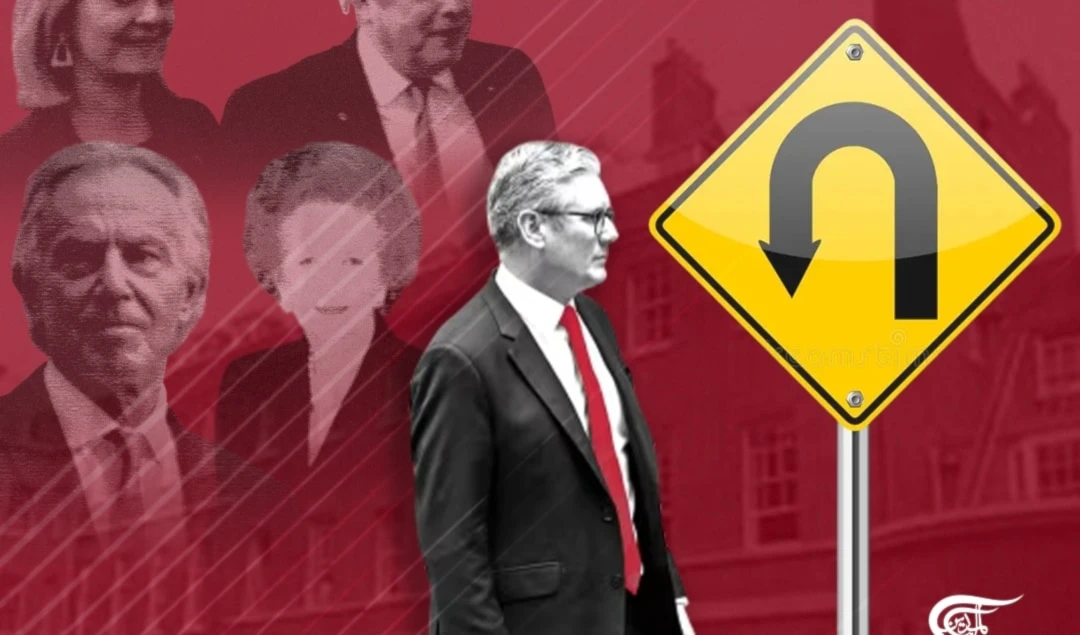News from Nowhere: The End of the World
The immediate future may sometimes look awfully bleak; but, as they always say, it’s not the end of the world – not quite yet.
-

News from Nowhere: The End of the World
Nearly seven hundred years ago, an occurrence of bubonic plague that became known as the Black Death swept through Asia, Europe, North Africa, and the Middle East. It is estimated to have resulted in the deaths of more than 100 million people, annihilating up to half the human populations in many of the regions that it hit.
Yet its aftermath kick-started the empowerment of European labour, as workforce shortages obliged landowners to start to move away from feudal economic models. It also resulted in waves of religious persecution and fanaticism. In Europe, it had a particular impact on the cultural influence of Christian eschatology, and its related narratives and imagery, intensifying that reputedly medieval fascination with death and the apocalypse.
The final book of the Christian Bible sees the legendary four horsemen of the apocalypse ride to their terrible triumph across the nations of the Earth. This motley and carious crew put into corporeal form the primal dread of those devastating scourges which still to this day blight the human race: famine, war, pestilence, and death. Little has changed since those gothic figures haunted medieval minds in an ageless iconography most famously captured in Albrecht Dürer’s classic woodcut print of 1498. The horror of their terrifying forms went on to echo throughout the late Middle Ages in the hellscapes of Hieronymus Bosch and in Bernt Notke's dances of death.
But these nightmare visions are not merely the stuff of outmoded superstition, the long-lost relics of more primitive times. Just open any newspaper today, and you will see horribly similar images from across the world continuing to appear with a cruel and remorseless persistence. It seems these apocalyptic archetypes will remain forever hidden in plain sight.
There is something about this danse macabre that appears deeply engrained in so many cultures. While Hinduism and Buddhism tend to view the progress of history as cyclic, the world’s great monotheistic religions have all foreseen conclusive moments of tribulation, resurrection and revelation. These beliefs are exaggerated to absurd proportions in the phenomena of the doomsday cults, those fringe movements which have endured, in one form or another, from the second century Montanist heretics all the way through to their late twentieth century incarnations in Waco and Aum Shinrikyo, charismatic groups whose prophecies are often prone to fulfil themselves in frenzied orgies of violence, destruction and wholesale slaughter.
However, it is not only such minority cults whose doctrines have heralded the oncoming apocalypse. More than twenty million Seventh-Day Adventists still believe in the impending return to Earth of Jesus Christ. There also remains something innately self-fulfilling in the forecasts of even the most mainstream, moderate and secular societies, when they come (as they so often do) to turn a disproportionate degree of attention towards the imminence of the end of the world. Modern media platforms are, in short, as adept as those marginal sects at accelerating the rise of such mass hysteria.
Between the late 1940s and the late 1980s, the apocalyptic fervour of many nations tended to be consumed by very real fears as to the sudden eruption of a nuclear conflict between the global superpowers. After 9/11, visions of terrorists wielding weapons of mass destruction began instead to grip western imaginations. Then, in 2020, the speed of the spread of a cataclysmic pandemic breathed an unexpected strain of new life into our talk of the end of days.
All this time, of course, the greatest single threat to the survival of human life and the continuation of civilization on this planet – the virtual certainty of the catastrophic effects of man-made climate change – has continued to grow, addressed by political rhetoric but by precious little real economic, industrial or social action. It sometimes seems that the nations of this Earth are incapable of putting their squabbles to one side and getting their acts together to confront the world’s most urgent challenges. Indeed, even today, despite the ongoing exigencies of viral and environmental crises, the threat of nuclear conflict has once more re-emerged, a blast from the past apparently prompted by comments incongruously attributed to Britain’s otherwise remarkably ineffectual and anodyne Foreign Secretary.
(One can imagine this particular faux pas being raised at that ardent Brexiteer’s next job interview: ‘I see that, while serving as Britain’s top diplomat, you managed to provoke World War Three.’ ‘Yes,’ she’d respond, ‘but I also reduced the UK’s dependency on imports of European cheese.’ In those terms, then, her record in office seems pretty evenly balanced. To be fair on the Foreign Secretary, though, it is not as if there have been any other senior members of the UK government likely to help the world avert this looming disaster. Last month, one of its least able ministers – a man curiously called Mr. Cleverly – declared that he did not believe that ‘what the country needs right now is a vacuum at the centre of government’. There are those who might point out that it therefore seems rather unfortunate that in December 2019 the nation had chosen to elect a moral and intellectual void into its most exalted office. There seems something peculiarly British in the prospect of an apocalypse of idiots.)
But is this really the beginning of the end times? It is easy enough, of course, to point out that the long history of recurrences of apocalyptic panics would appear to demonstrate the groundlessness of the anxieties underpinning them. Each generation has tried its worst to prove its own significance by convincing itself that it is experiencing humanity’s very last gasp. Everyone has always said the world is about to end, but it certainly hasn’t happened yet.
Yes, it’s easy enough to say this, when one is sitting in the relative comfort and safety of a temperate little island wedged between mainland Europe and the Atlantic Ocean: when one is not suffering unrelenting civil persecution, nor facing deportation to a death camp; when one is not fighting to defend the lives of one’s family; when one’s Pacific atoll home is not being lashed by the inexorably rising tides; when one is not struggling to breathe through inflamed lungs, nor tearing bloody swellings from one’s own groin; when one’s eyeballs have not begun to boil, when one’s flesh has not yet started to ignite.
The catastrophes caused by pandemic and climate change are exacerbated by denial, inaction and neglect. By contrast, the crises provoked by ideological and geopolitical conflicts are liable to be escalated by a paranoid focus upon the prospect of an impending Armageddon. Those who sincerely believe the world is soon going end are unlikely to be the most reliable assessors of strategic risk. On the contrary, they may be inclined to gamble everything upon a remote chance of salvation.
In the late 1980s, the British novelist and journalist Martin Amis questioned the viability of the doctrine of ‘Mutually Assured Destruction’ as a strategy for the prevention of nuclear holocaust. Amis argued that there are two main problems with this idea: the fact that nuclear war is unthinkable (and therefore we deny its possibility and its risk), and the fact that it is simultaneously believable (and therefore we plan for it in ways which make it more real). The utter crushing madness of this paradox was neatly captured by Amis when recounting how, on a visit to a nuclear control bunker beneath Washington, his attempt to light a cigarette was met with shock and outrage on the part of his American military hosts. He identified an appropriately insane irony in the discovery that those ‘inferno artists should all go green at the sight of a Marlboro’. The devoted guardians of the United States’s nuclear arsenal had been inordinately scandalized by Amis’s blasé attitude to tobacco: after all, they reasoned, that stuff can actually kill you.
Last week, a dear old Tory friend of mine – whose presence in my life may be familiar to regular readers – advised me that, in the event of the outbreak of a nuclear war, the best thing to do would be to stay safely at home and thereby, wherever possible, to avoid going outside into the realm of scorching dust and radioactive rain. The British government had issued strikingly similar advice in response to the arrival of coronavirus: stay home to save lives. In the case of Covid-19, however, it was not considered necessary to tape wet blankets to one’s windows, to hide under a sturdy table, or to wear a hat hand-crafted from aluminium foil.
It is when we learn to live with nuclear weapons that their use becomes an actual possibility, because we can only live with them by not thinking about them too much. This in turn means that we end up failing to do very much about them at all. Like climate change, the threat of atomic holocaust had become, during the Cold War, an accepted part of the landscape of contemporary existence. It was like a truly repellent wallpaper that everyone did their best to ignore. It was like living next door to a highly toxic chemical plant with a very lax attitude to safety protocols.
Perspectives upon this monumental peril became almost casual. The risk was accepted as a fact of life, as just the way things were. There was something unprecedentedly dangerous in this. The so-called ‘nuclear umbrella’ was always hair-triggered and razor-edged. It could snap shut at any moment and decapitate us all. This is not a situation to which anyone should ever wish to return. Under such circumstances, and especially when fueled by a heady mix of aggressive jingoism and an apocalyptic mindset pumped up on the psychotropic steroids of political machismo, the escalation of hostilities would invariably appear to guarantee catastrophe.
There are, of course, those who might observe that the looming likelihood of a global nuclear war is at least a great leveller. It puts post-industrial western nations on an equal footing – in terms of their existential precarity – with all the rest of the world. However, it would take the nihilism of a Hollywood supervillain to find that a good reason to welcome it. In truth, even Thanos and Blofeld might balk at the prospect.
The immediate future may sometimes look awfully bleak; but, as they always say, it’s not the end of the world – not quite yet. The Anglo-American poet T. S. Eliot famously proposed that the world would end not with a bang but a whimper. But perhaps the way the world ends, whether in an explosive conflagration or in a quiet acquiescence to its fate, is simply when we stop striving to save it, when we accept the inevitability of its demise, or when we fail to remain alert to the extraordinary capacity of things to fall apart.
It is for all people of good conscience, of whatever political or national stripe, to maintain the urgency of that awareness, and to challenge our leaders when we see them starting once again to let things slide. Tinpot despots and pint-sized warmongers may forever rear their unlovely heads; and yet, we must say, at the last they shall not pass. For as long as such threats might persist, let that be humanity’s undying and unifying cry.

 Alex Roberts
Alex Roberts
 11 Min Read
11 Min Read











